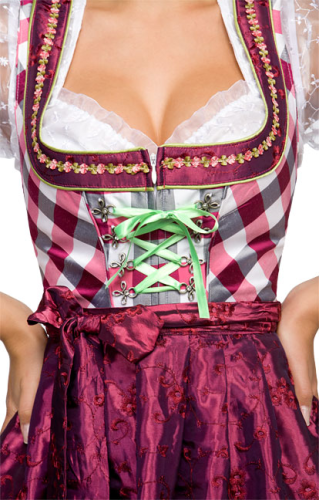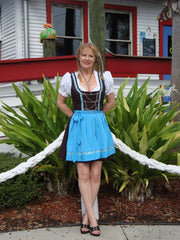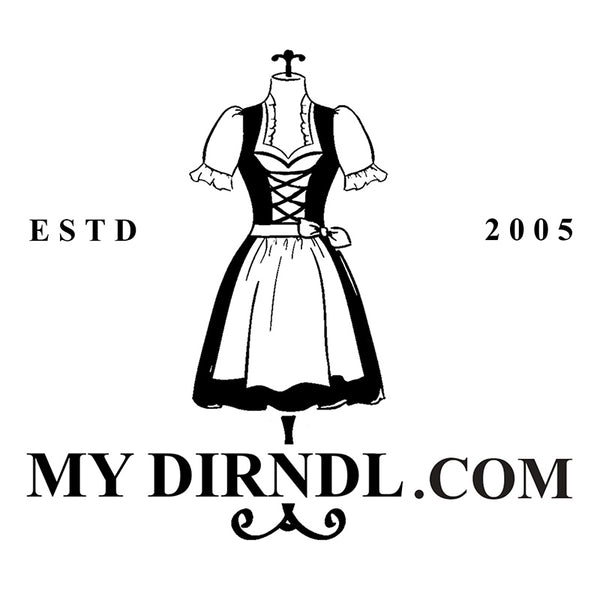
♥ Bavarian Dirndls from Germany ♥
Share
 A Dirndl is traditional clothing or "tracht" worn for formal occasions or celebrations in southern Germany, Austria and Liechtenstein. The Dirndl costume usually consists of a bodice, blouse, full skirt, and apron.
A Dirndl is traditional clothing or "tracht" worn for formal occasions or celebrations in southern Germany, Austria and Liechtenstein. The Dirndl costume usually consists of a bodice, blouse, full skirt, and apron.
The word “Dirndl” originates from southern Germany, where in the regional dialect it originally meant a young woman or girl. The Dirndl was the uniform of Austrian housemaids in the 1800s. Dirndlgewand,” which the word “Dirndl” comes from, means “maid’s dress.” Today, Dirndl can refer to either a young woman or the dress she wears. The Dirndl was also traditionally worn as a work outfit by the female peasant class. Farm girls and farmers’ wives, dairymaids, and housewives wore the Dirndl to do their chores. Each village typically had its own style or crest to identify where the wearer was from. Dirndls, Lanhausmode, Lederhosen, and other traditional costumes found at www.mydirndl.com display some of the colors, crests, and embroideries from different groups and geographical regions.
Farm girls and farmers’ wives, dairymaids, and housewives wore the Dirndl to do their chores. Each village typically had its own style or crest to identify where the wearer was from. Dirndls, Lanhausmode, Lederhosen, and other traditional costumes found at www.mydirndl.com display some of the colors, crests, and embroideries from different groups and geographical regions.
Dirndl styles can vary from knee-length or low-calf length, high-or low-necked, and can be plain or have elaborate patterns or embroidery. In many regions, ladies wear a shawl or scarf as an accessory to their Dirndls. Winter Dirndls are usually long-sleeved, made of heavier materials such as wool, and feature rich, dark colors. Summer Dirndls are lightweight, often made of cotton, and have shorter sleeves and brighter colors. During the summer months, women wearing Dirndls often went barefoot.
Traditionally, the placement of the knot on the apron indicates a woman’s marital status. A knot tied to the right of the apron means a woman is married, engaged, or “spoken for;” a knot tied on the left means she is single and available, and a knot on the back indicates she is widowed. The apron, now a fun accessory, was historically a practical garment used for all sorts of activities, such as gathering berries or storing scissors and other supplies.
Eventually, when the German Kaiser at the time decided Dirndls and other folk clothing were fashionable, Austrian upper-class women began wearing the Dirndl, or "G'wand,” on their summer vacations. The simple peasant uniform was adopted as high fashion by the ladies of society. It didn’t hurt that the traditional Dirndl is designed to flatter women, with a tight waist and bodice to emphasize the figure and a full skirt designed to conceal real (or imagined) flaws.
Today, the Dirndl, similar to the kilt, displays the wearer’s national pride. Women wear their Dirndls for traditional cultural events or weddings and other formal occasions. They are commonly worn by workers in the tourism industry and today are probably most known by their appearance at Oktoberfest, the huge festival celebrating southern German culture that attracts people from around the world. If you come from a culture of German-speakers, it would be great to add a Dirndl to your collection of other historic and modern pieces. It’s wearable art that looks great and flatters every woman, from shorter to taller, from thin frames to larger ones.
Over the years, there has been a movement to preserve and promote the history and culture of “Trachten” (type of clothing and look that historically identified 
Prost!
Die Dirndl Frau
